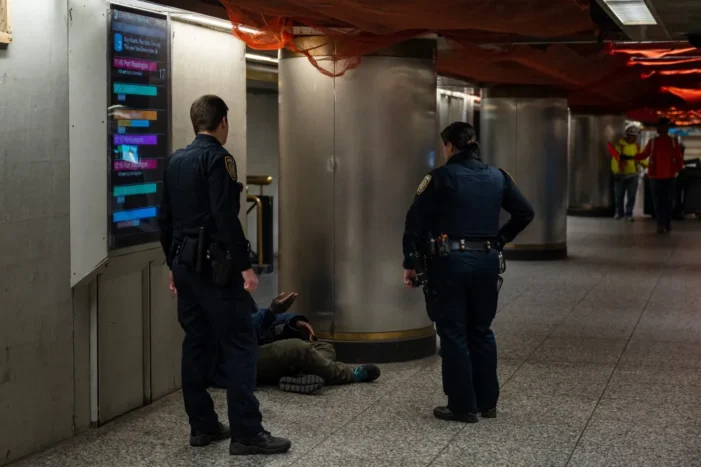Police officers talk with a person who was swiping in subway riders at Penn Station, Dec. 9, 2022. Credit: Hiram Alejandro Durán/THE CITY
By
Gov. Kathy Hochul on Wednesday announced the latest in a series of subway safety initiatives, placing MTA police officers, state troopers and 750 National Guard members at some of the city’s busiest stations to conduct bag checks.
Following some headline-grabbing incidents underground — including the slashing last week of a conductor that led to what a top transit official called “some kind of work-stoppage charade” by the transit workers union — Hochul said beefing up the uniformed presence in stations will curb rider and worker fears.
“There’s a psychological impact, people worry they could be next, anxiety takes hold,” the governor said. “And riding the subway, which would be part of your everyday life, is filled with stress and trepidation.”
Hochul unveiled a “five-point plan to rid our subways of people who commit crimes” while standing alongside police officers, National Guard troops and MTA Chairman and CEO Janno Lieber at New York City Transit’s Rail Control Center in Midtown.
The five elements are: deploying about 1,000 more uniformed personnel for bag checks; accelerating the installation of cameras on every train and in conductor cabs; a proposed bill that would allow judges to ban people convicted of assault; expanding the number of mental health response teams; and holding regular meetings between transit personnel, police and prosecutors.
The MTA’s police force, which patrols the Long Island Rail Road and Metro-North, already posts officers at subway stations connected to commuter rail hubs.
‘Blood Has Been Spilled’
The latest anti-crime effort in the subway comes as NYPD numbers show transit crime in 2024 through March 3 is up by 13% from the same period last year and just last week TWU International President John Samuelsen said assaults on workers have increased by nearly 60% from last year.
“No one should have to go through what Alton Scott went through,” Lieber said, citing the veteran subway conductor who was slashed in the neck last week.
Overall, crime in the subway system is rare. According to the MTA’s latest data from January, less than two major crimes took place per one million riders that month. Major crimes are defined by the NYPD as burglary, felony assault, robbery, grand larceny, rape and murder.
Richard Davis, president of Transport Workers Union Local 100, praised the plan to put more police in stations, while saying the union’s calls for beefed-up subway security were ignored for months.
“As a result, riders and workers alike have suffered,” Davis said. “While MTA leadership willfully looked the other way, blood has been spilled.”
Hochul and Mayor Eric Adams — who pinned his absence from the latest subway safety announcement on a scheduling conflict — have previously unveiled multiple versions of plans to cut into subway crime and homelessness by increasing the number of police officers in stations.
In an interview on WPIX-11 Wednesday along with Chief Michael Kemper, head of the NYPD Transit Bureau, Adams insisted the new bag checks would not lead to racial or ethnic profiling.
“We’re not profiling, we’re random based on the count, a number,” the mayor said. “And people who don’t want their bag checks can turn around and not enter the system. You don’t have to come through and do the bag checks, but they are random.”
And on Fox 5 Wednesday morning, Adams noted that subway crime was down overall in 2023, “but in January we had a bad month” — which led to an earlier surge of police in the system.
Could Backfire
Riders Alliance, an advocacy group for straphangers, said the “well-intentioned” placement of troops at gateways to busy subway stations could work against the MTA as it struggles to overcome riders who see the system as unsafe.
“While well-intentioned, deploying troops to subway entrances is more likely to increase the perception of crime among people who don’t ride public transit than to protect the millions of riders and workers on platforms and trains each day,” said Danny Pearlstein, the group’s policy director.
Hochul’s latest subway safety plan also drew criticism from the New York Civil Liberties Union head Donna Lieberman — who called it “another unfortunate example of policymaking through overreaction and overreach” and the group Communities United for Police Reform.
“Governor Hochul’s misguided plan will only exacerbate racial profiling and abusive policing of Black and LatinX New Yorkers,” said Ileana Méndez-Peñate, a spokesperson for the group.
The Adams administration has often had to rely on using overtime to boost the police presence in the subway — with many officers seeming to be standing around doing nothing.
In 2022, Adams called on riders to snap photos of inattentive police in stations and email them to the mayor’s press office.
As THE CITY revealed at the time, little action came from that campaign. That same year the MTA rolled out announcements about NYPD presence in stations that some transit workers said were worthless.
The deployment of National Guard troops is also something transit officials considered in the spring of 2020 but, as THE CITY reported, MTA officials instead put more of the transit agency’s own police and private security into stations amid a robbery spike early in the pandemic.
This story was published by THE CITY on March 6, 2024.




